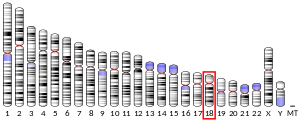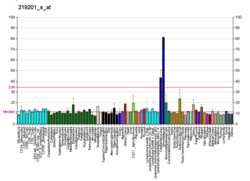Twisted gastrulation protein homolog 1 is a protein that in humans is encoded by the TWSG1 gene. The protein is a binding protein for bone morphogenetic proteins, similar to Chordin. The Twisted gastrulation gene is expressed in the extraembryonic tissues during organogenesis, and in certain adult tissues such as the lymph nodes, kidneys, liver, and lungs.
References
- ^ GRCh38: Ensembl release 89: ENSG00000128791 – Ensembl, May 2017
- ^ GRCm38: Ensembl release 89: ENSMUSG00000024098 – Ensembl, May 2017
- "Human PubMed Reference:". National Center for Biotechnology Information, U.S. National Library of Medicine.
- "Mouse PubMed Reference:". National Center for Biotechnology Information, U.S. National Library of Medicine.
- Scott IC, Blitz IL, Pappano WN, Maas SA, Cho KW, Greenspan DS (Mar 2001). "Homologues of Twisted gastrulation are extracellular cofactors in antagonism of BMP signalling". Nature. 410 (6827): 475–8. doi:10.1038/35068572. PMID 11260715. S2CID 4392365.
- "Entrez Gene: TWSG1 twisted gastrulation homolog 1 (Drosophila)".
- Oelgeschläger M, Larraín J, Geissert D, De Robertis EM (2000). "The evolutionarily conserved BMP-binding protein Twisted gastrulation promotes BMP signalling". Nature. 405 (6788): 757–63. Bibcode:2000Natur.405..757O. doi:10.1038/35015500. PMC 2292104. PMID 10866189.
- Graf D, Timmons PM, Hitchins M, Episkopou V, Moore G, Ito T, Fujiyama A, Fisher AG, Merkenschlager M (July 2001). "Evolutionary conservation, developmental expression, and genomic mapping of mammalian Twisted gastrulation". Mammalian Genome. 12 (7): 554–560. doi:10.1007/s0033501-0005-x. ISSN 0938-8990. PMID 11420619. S2CID 36371559. Retrieved 6 March 2023.
Further reading
- Graf D, Nethisinghe S, Palmer DB, et al. (2002). "The developmentally regulated expression of Twisted gastrulation reveals a role for bone morphogenetic proteins in the control of T cell development". J. Exp. Med. 196 (2): 163–71. doi:10.1084/jem.20020276. PMC 2193926. PMID 12119341.
- Strausberg RL, Feingold EA, Grouse LH, et al. (2003). "Generation and initial analysis of more than 15,000 full-length human and mouse cDNA sequences". Proc. Natl. Acad. Sci. U.S.A. 99 (26): 16899–903. Bibcode:2002PNAS...9916899M. doi:10.1073/pnas.242603899. PMC 139241. PMID 12477932.
- Zakin L, De Robertis EM (2004). "Inactivation of mouse Twisted gastrulation reveals its role in promoting Bmp4 activity during forebrain development". Development. 131 (2): 413–24. doi:10.1242/dev.00946. PMID 14681194.
- Ota T, Suzuki Y, Nishikawa T, et al. (2004). "Complete sequencing and characterization of 21,243 full-length human cDNAs". Nat. Genet. 36 (1): 40–5. doi:10.1038/ng1285. PMID 14702039.
- Moreno M, Muñoz R, Aroca F, et al. (2005). "Biglycan is a new extracellular component of the Chordin-BMP4 signaling pathway". EMBO J. 24 (7): 1397–405. doi:10.1038/sj.emboj.7600615. PMC 1142540. PMID 15775969.
- Otsuki T, Ota T, Nishikawa T, et al. (2007). "Signal sequence and keyword trap in silico for selection of full-length human cDNAs encoding secretion or membrane proteins from oligo-capped cDNA libraries". DNA Res. 12 (2): 117–26. doi:10.1093/dnares/12.2.117. PMID 16303743.
- Tzachanis D, Li L, Lafuente EM, et al. (2007). "Twisted gastrulation (Tsg) is regulated by Tob and enhances TGF-beta signaling in activated T lymphocytes". Blood. 109 (7): 2944–52. doi:10.1182/blood-2006-03-006510. PMC 1852213. PMID 17164348.
This article on a gene on human chromosome 18 is a stub. You can help Misplaced Pages by expanding it. |




